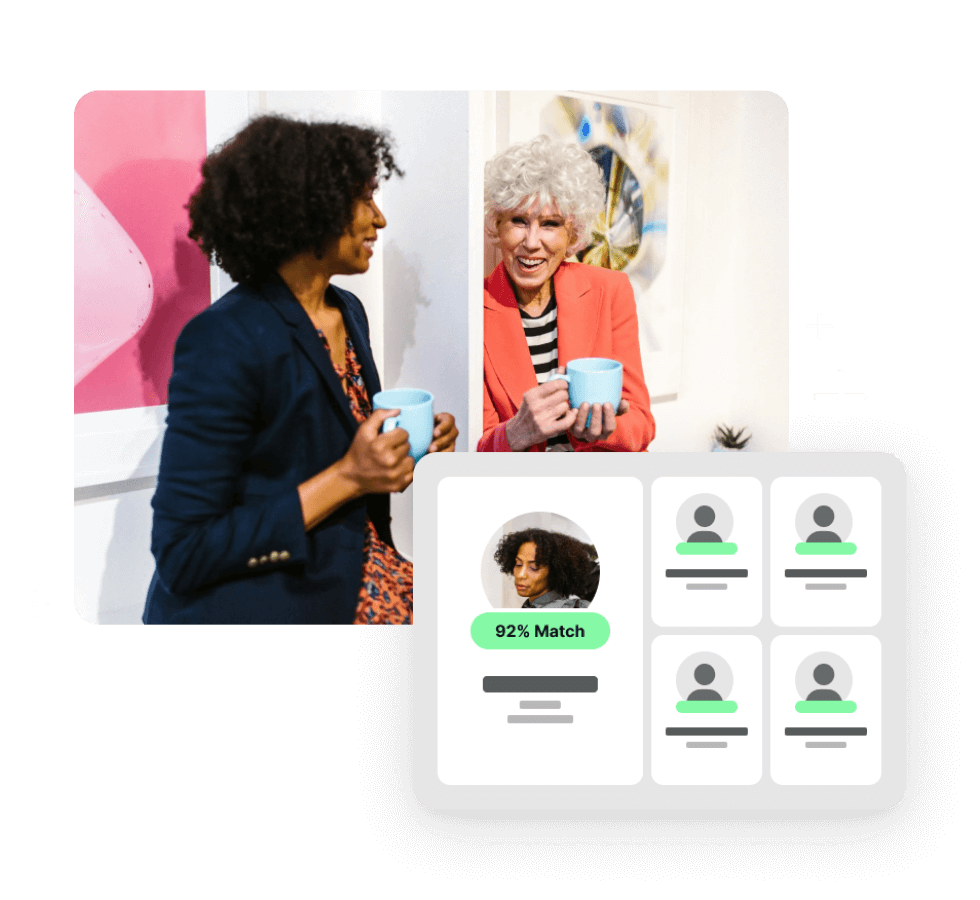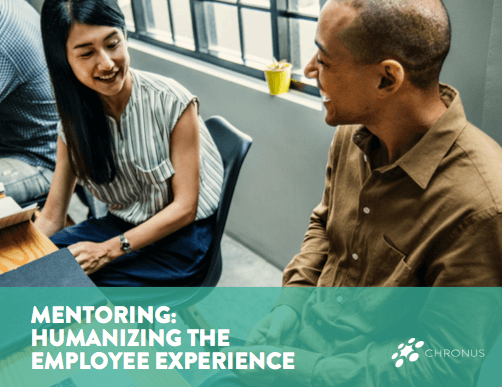🎉 Introducing Guided Mentoring to reduce participant uncertainty Read News Release
Mentoring: Humanizing the Employee Experience

Where Companies Miss the Mark
on Employee Engagement
In our increasingly digital and tech-driven workplace, 87% of employees in the U.S. are not engaged—they are not involved in, enthusiastic about or committed to their work or workplace— according to Gallup’s latest annual research1. As a result, U.S. companies are losing a whopping $450 billion a year in productivity due to employee experience.
That’s a staggering loss. And it explains why improving employee engagement tops the list of business priorities. But as many organizations are learning, meeting that priority is a formidable challenge. A one-size-fits-all solution does not exist, and one-off solutions do not work.
Yet, in examining companies where engagement is high, a common theme emerges: these organizations have created a humanized employee experience of inclusion, development and support. These three elements drive innovation, collaboration and ultimately deliver superior business results. Altogether, this holistic approach to engagement produces greater revenue returns and happier employees.
87% of employees in the U.S. are not engaged – they are not involved in, enthusiastic about or committed to their work or workplace— according to Gallup’s latest annual research
While inclusion and development have been on company radars for a while, most organizations are tackling these initiatives all wrong. Firstly, mandatory diversity trainings and grievance hearings aren’t making the grade when it comes to building long-term inclusion in the workplace2. Oftentimes, these tactics can prove costly, ineffective and in some cases, may even be producing a negative effect. Secondly, and despite good intentions, most organizations are throwing away money on ineffective development and training, resulting in scrap learning. According to CEB Global, scrap learning—knowledge that isn’t applied back to the organization—currently makes up about 45% of organizational training. And finally, companies are overlooking the engaging aspect of support altogether, leaving employees feeling isolated and unvalued as contributors in the workplace3.
How can your company build a culture of inclusion, development and support? The answer begins with humanizing the employee experience across the entire employee lifecycle. And to do that, mentoring will be your most valuable asset.
In this ebook, you’ll learn:
- Why humanizing the employee experience is important for a company’s future and bottom line
- How mentoring applies a humanized approach to the employee experience
- Which mentoring programs best align with your organizational goals
Humanizing the Employee Experience
What Does Humanizing the Employee Experience Mean?

Creating Inclusion.
Humanizing the employee experience by promoting open communication, collaboration and interaction across demographics and job function on an individual level imparts a sense of belonging for employees in the organization4.
Enabling Development.
A recent Work Institute study found that a lack of career development is the number one reason employees leave a company5. Therefore, a company’s investment in an employee from a growth and advancement stand point is a major component of engaged retention.
Building Support.
Organizations must help employees build support networks and friendships with those around them. Gallup found that having a friend at work can increase engagement among employees6. Without this support, employees can flounder.
“Employees without close or supportive relationships at work are more likely to feel disconnected from their jobs and that can affect their performance,” said Darcy Gruttadaro, director of the Center for Workplace Mental Health. “There is a direct correlation between loneliness, productivity and absenteeism.” In addition, better support structures in companies can encourage and back up aspects of continued development and upskilling for greater organizational productivity.
Humanizing engagement can position a company at the forefront of innovation and best places to work.
Get the eBook Now
Download the Free eBook to Take on the Go

Why Is Improving Employee Engagement Important?

Greater Profits
Companies with strong employee engagement outpace businesses where engagement is weak. According to Gallup, organizations with highly engaged workforces outperform their competitors by 147% in earnings- per share and have 21% percent higher profitability7. Inclusion, as a vital component to engagement, has its bottom line benefits as well. Research from McKinsey & Company points out: Companies in the top quartile for racial and ethnic diversity are 35% more likely to have financial returns above their respective national industry medians8.
Better Customer Experience
Organizations with highly engaged workforces outperform their competitors by 147% in earnings – per share and have 21% percent higher profitability
Happy employees equal happy customers. Customer experience and outcomes are often tied to individual employee performance and assessment. In order for one to be successful, the other must also perform well. McKinsey & Company findings suggest “the employee experience reflects the customer care the organization seeks to create9.” In accordance, Research from IBM® Smarter Workforce Institute and Workhuman® iQ shows organizations that score in the top 25% on employee experience report nearly 3x the return on assets and 2x the return on sales.
Increased Retention
Improving the employee experience also helps companies retain their top talent in the increasingly competitive U.S. labor market – where 51 percent of workers are actively looking for new jobs or watching job openings11. Why? Because when employees feel highly engaged, they are far less likely to jump ship. Retention not only builds continuity and organizational morale, but also helps companies avoid hefty hiring, onboarding and training costs.
Competitive Hiring
51% of workers are actively looking for new jobs or watching job openings
Optimizing the employee experience by building a humanized culture of—and reputation for—inclusion, development and support can enable organizations to become an “employer of choice” among the most coveted prospective employees. Employers that take an active interest in their employees’ growth and learning gain a competitive edge in the recruitment arena. This is increasingly important as today’s talent pool ushers in the most diverse class of workers yet, the majority of whom are millennials who value diversity and purpose and will represent more than half of the U.S. workforce by 202012.
How Do You Humanize the Employee Experience?
In order to humanize the employee experience, organizations must build out the elements of inclusion, development and support that empower employees to feel like more than another cog in the wheel. A proper strategy encompasses a human element that welcomes individual employees, connects them with others in their networks, and develops them through the next stages of their professional growth.
Mentoring bridges those gaps in the employee experience. Its very nature brings people together in order to learn from each other and support the advancement of individuals in an organization. This is why over 71% of Fortune 500 companies offer a corporate mentoring program13. Mentoring is the ideal strategy to create holistic engagement that can increase profits, retention, customer satisfaction and recruitment.
Want to see how mentoring’s impact on retention? Calculate Impact With Our Employee Retention ROI Calculator
We’ve seen how industry- leading organizations have utilized mentoring to efficiently and cost-effectively improve their employee engagement throughout:
- Onboarding
- Creating a culture of inclusion
- Career development
- Upskilling and continuous learning
- Leadership development
- Succession planning
At each of these stages, mentoring helps improve the employee experience by welcoming in all employees, facilitating the sharing of knowledge and skills, and providing the support of networks and connections for personal and professional growth.
Can your company achieve these types of results?
The answer is a definitive “yes.” In the following sections, we’ll take a deeper dive into how a formal mentoring strategy can humanize the employee experience across your employee lifecycle.
Learn how Chronus maps mentoring to your unique employee experience
Onboarding
Accelerate Integration and Productivity

Why do so many new hires leave? More often than not, a poor onboarding experience is to blame. Only 32% of companies have formal onboarding programs16. For those who do, about half see increased new hire productivity and retention17. Subpar or rushed onboarding can leave new employees feeling disengaged, overwhelmed, stunted and looking for greener pastures outside company walls.
With the war for corporate talent in full swing, companies need strategic onboarding programs that engage employees to ensure they won’t be leaving anytime soon. Mentoring can be the key driver.
Inclusion
Build Diversity, Foster Sense of Belonging and Innovation

According to the 2017 Tech Leavers Study, 40% of employees who departed companies said their personal experiences of exclusion, unfairness or mistreatment played a major role in their decision to leave19. Even just witnessing unfairness or exclusionary tactics weighed heavily on those employees’ decisions to walk out.
According to the 2017 Tech Leavers Study, 40% of employees who departed companies said their personal experiences of exclusion, unfairness or mistreatment played a major role in their decision to leave.
Put simply, employees leave when they don’t feel included. What causes them to feel this way? Most often, according to Catalyst research, it’s because they’ve experienced tokenism, bias and stereotyping20.
The message here is clear: Recruiting can’t be the sole solution for diversity and inclusion. Organizations can recruit employees who represent the entire social and demographic spectrum of the population, but they will lose many of them if they neglect to take the steps to ensure all of their employees feel included in the company.
Ultimately, by failing to align inclusion with their diversity initiatives, companies will not only see some of their best and brightest people walk out the door, but also miss out on the significant financial, innovative and collaborative benefits that diverse teams produce21.
Career Development
Build Employee Competency and Career Paths

As companies seek to fill open positions with high- performing employees, they’re also keeping a close eye on their internal capabilities to grow those workers, building competent talent sources for the jobs of the digital, upskilled future. This makes the opportunities and development employers offer all the more vital for the health of the business.
According to LinkedIn, two out of every three employees join companies for better career paths or more opportunity 25. And just as quickly as they move in, 45% of employees move out because of a lack of advancement opportunities.
All of this means that traditional L&D approaches to career development such as trainings, classes and seminars won’t cut it anymore. Companies looking to remain competitive in the talent market will have to focus on programs and career pathing that both fuel engagement with experiential learning and increase satisfaction and retention throughout the employee experience.
Upskilling
Accelerate Continuous Learning and Employee Progression

But that bright future—and the competitive advantages that come with it— can only be unlocked by companies that ensure their employees are all up to speed on the latest technology.
Further, upskilling isn’t just a matter of adopting the newest technology. When companies adopt new business technology, like a new Customer Relationship Management (CRM) system, or a new IT ticket management system, those investments are best served by equipping employees with the knowledge and skills they need to leverage those technologies to the fullest.
The impetus is on employers to make sure their workforce is constantly upskilling to stay ahead of the curve. Organizations are well served by promoting continual learning initiatives that emphasize tech fluency to help all employees grow and thrive27.
Ultimately, in this new world of tech-driven innovation, proper proactive upskilling can provide employee growth while boosting workforce morale and engagement within the workplace.
Leadership Development
Bolster the Pipeline of High-potential Talent

This mass exodus makes companies especially vulnerable on the leadership front, according to Deloitte research which reveals that 86% of business and HR leaders today believe they lack an adequate leadership pipeline30.
To address this gap, companies are looking both inside and outside of their organizational walls for their next generation of leaders. Yet, filling leadership roles with external candidates can prove costly. The time and expense to ramp up new employees can quickly drain valuable resources.
86% of business and HR leaders today believe they lack an adequate leadership pipeline
What’s more, external hires get significantly lower performance evaluations for their first two years on the job than do internal workers who are promoted into similar jobs, according to the Wharton Knowledge Report, “Why External Hires Get Paid More, Perform Worse31.” The report also finds that external hires have higher exit rates and are paid about 20% more.
That’s why companies are increasingly looking inward and preparing existing employees to move up to the leadership ranks. They are taking steps to ensure that the tribal knowledge from existing leadership is passed efficiently and effectively to their future potential leaders.
Succession Planning
Elevate Knowledge Transfer and Organizational Resilience

This can be a disastrous situation. To avoid it, companies must build and implement a succession plan that enables them to proactively stay on top of their game after their star players leave. With a strong plan in place, the departure of senior leader can be a managed event instead of a crisis. When properly orchestrated, succession planning can lead to profitable results and better employee retention.
In Conclusion
Mentoring humanizes the employee experience across the entire employee lifecycle, helping to ensure your employees feel included, developed and supported in the organization. These components will increase productivity, and ultimately lead to better engagement across the board. And increased engagement will make them ready, willing and able to climb to the top rungs of the company ladder.
In collaborating with some of the world’s largest organizations to develop successful mentoring programs, we’ve seen what can happen when companies leverage mentoring to humanize the employee experience. They can achieve remarkable outcomes at every milestone
of the employee journey: onboarding, inclusion, career development, upskilling, leadership development and succession planning.
The organizational and financial ROI of mentoring continually push it into the need-to-have column for competitive companies.
Humanizing your employee experience at every stage through mentoring puts your company on the fast track to improve employee engagement, become the employer of choice among the top talent in your industry and build a pipeline of qualified leaders for future success.
To learn what type of mentoring best fits with your employee engagement goals and stage of the employee experience, download the full ebook.
REFERENCES
*See references in the ebook.
Mentoring Software Can Help
Watch the video to see how the Chronus mentoring platform makes it easy to start, manage, and measure modern mentorship programs.
